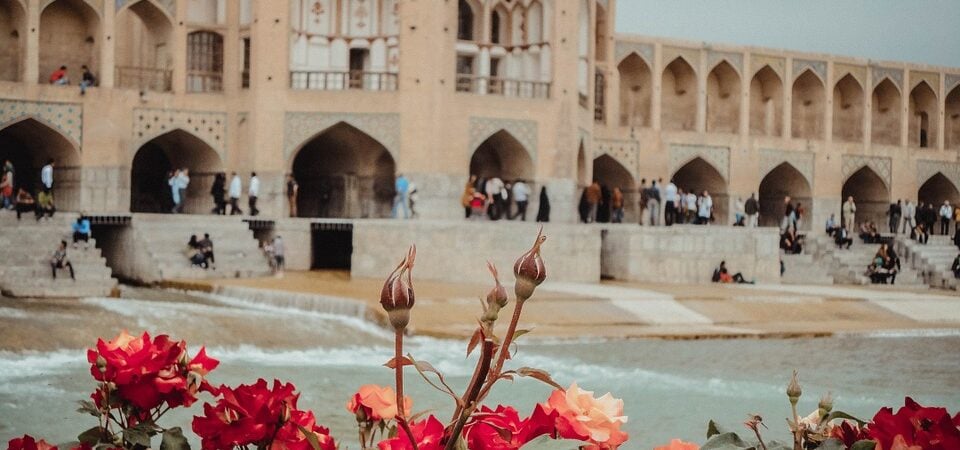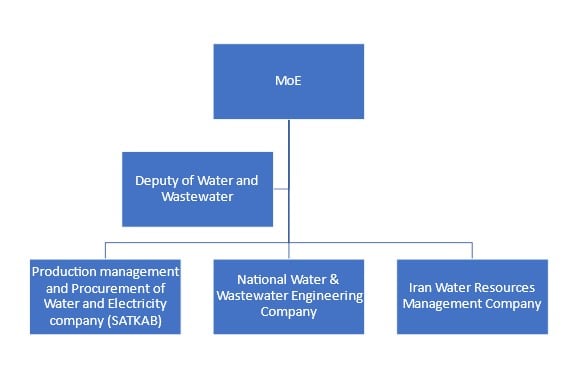
Organizations
According to Iran’s water legislation, three ministries are directly responsible for water resources assessment and development:
1.The Ministry of Energy (MoE)
MoE was established in 1936 to provide electricity for the country. In 1943, the ministry’s duties expanded to include water management. MoE was named the Ministry of Water and Electricity before it was renamed as the Ministry of Energy in 1975.
MoE has two responsibilities: energy supply, and water and wastewater services. [1] As far as irrigation is concerned, it is in charge of the construction of large hydraulic works, including dams as well as primary and secondary irrigation and drainage canals for the distribution of water.

Within the MoE, the Deputyship for Water Affairs is responsible for overseeing and coordinating the planning, development, management and conservation of water resources. This deputyship consists of the following sections: Water Resources Management Company (WRMC), Provincial Water Authorities (PWA), Irrigation and Drainage Operation and Maintenance Companies (O&M). WRMC is the mother company that manages all water sectors within the MoE, except drinking water distribution for rural and urban areas. PWAs are responsible for the water sector, including irrigation and drainage development and operation, in each province. Drinking water distribution is the responsibility of provincial water and wastewater companies. O&M companies are responsible for modern irrigation and drainage operation and maintenance. Forty-nine per cent of the shares of these companies is held by the MoE and 51% is held by the private sector. There are 19 O&M companies working under the supervision of the PWAs.[2]
2. The Ministry of Agriculture (MoA) is responsible for supervising rain-fed and irrigated crop development. Whereas the MoE is in charge of water management from the river source up to the level of secondary irrigation canals, the MoA is in charge of subsurface drains, tertiary and quaternary canals as well as farm development and irrigation techniques, planned and operated by the Provincial Agricultural Organizations and the Deputy Ministry for Infrastructure Affairs of the Ministry of Agriculture. [4]
3. The Department of the Environment (DoE) is responsible for drafting environmental protection policies and the laws, directives and systems necessary for evaluating the environmental impacts of social and economic development projects, particularly irrigation and hydropower projects, and monitoring their implementation.
In addition to the above ministries, the Ministry of Health and Medical Education is in charge of monitoring the physical, chemical, biological and bacteriological quality of drinking water from its source to consumption points.[5]
Laws and Regulations
In 1982, the first water law after the revolution in Iran was approved. The law stated that MoE is responsible for allocating and issuing permits to use the water for domestic, agricultural, and industrial purposes.
Article 1 of the Nationalization of Water Resources Act in Iran states that all water bodies, including surface and groundwater, are national wealth and belong to the public. The government is responsible for managing, safeguarding and the utilization of these resources.
As the government is responsible for the provision of water, the private sector is highly investing in drilling wells. Then, the wells are being operated and managed by farmers. The private sector has also been increasingly involved in financing water projects in recent years, especially irrigation and drainage systems. This is due mainly to the increase of awareness in natural resources preservation.
Moreover, Iran’s irrigation institute has the right to collect fees from the allocation of water and form societies, and it involves private owners in its work. The institute was established in 1943 to supervise irrigation projects.[6]
[1] Ministry of Energy. Available at https://www.moe.gov.ir/%D9%88%D8%B2%D8%A7%D8%B1%D8%AA-%D9%86%D9%8A%D8%B1%D9%88
[2] AQUASTAT, 2008. Country Fact Sheet: Iran. FAO’s global information system on water and agriculture. Available at www.fao.org/nr/water/aquastat/countries_regions/irn/index.stm.
[3] Ministry of Energy. Available at https://www.moe.gov.ir/Icons-Menu/Flowchart
[4] AQUASTAT, 2008. Country Fact Sheet: Iran. FAO’s global information system on water and agriculture. Available at www.fao.org/nr/water/aquastat/countries_regions/irn/index.stm.
[5] Ibid.
[6] Zekri, S. ed., 2020. Water Policies in MENA Countries (Vol. 23). Springer Nature. Available at https://doi.org/10.1007/978-3-030-29274-4
